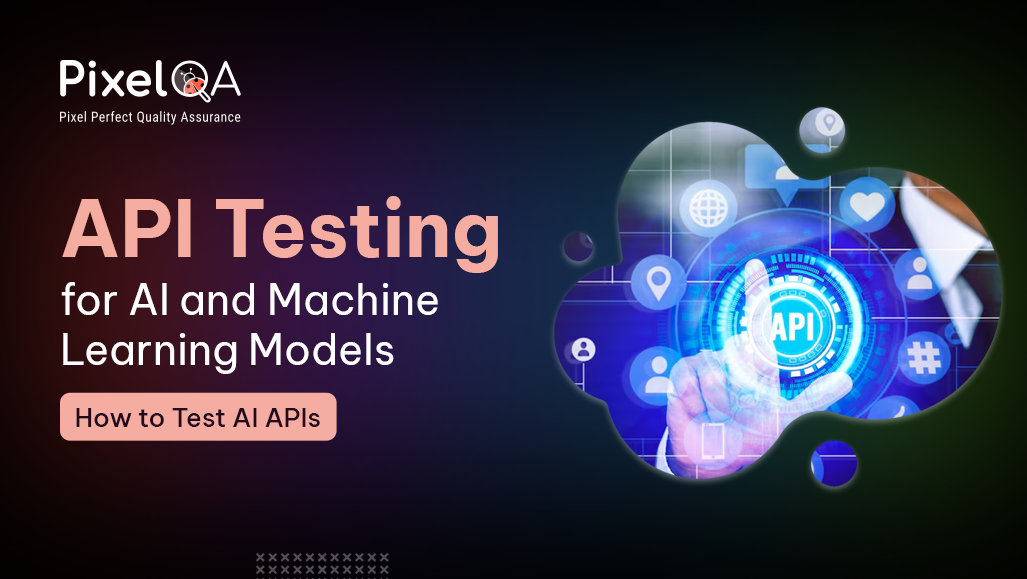
Table of Contents
- Introduction
- Understanding AI APIs
- Key Challenges in Testing AI APIs
- Approach to Testing AI APIs
- Best Practices for AI API Testing
- Tools for Testing AI APIs
- Conclusion
Introduction
Artificial Intelligence and Machine Learning have become known as key components of innovation in the quickly changing field of technology. Application Programming Interfaces are necessary for connecting AI/ML models to applications so that programmers may take advantage of these technologies' potential. However, because AI/ML models are basically complicated and unpredictable, evaluating AI APIs presents special difficulties. This blog discusses how to properly test AI APIs to make sure they operate successfully for any API testing company, fairly, and dependably.
Understanding AI APIs
AI APIs are interfaces that expose AI/ML functionalities, such as:
- Image Recognition: Detecting objects or faces in images.
- Natural Language Processing: Analyzing sentiment, extracting entities, or translating text.
- Recommendation Systems: Offering personalized content or product recommendations.
Examples include Google Cloud AI, OpenAI API, IBM Watson, and AWS AI/ML services. These APIs make it easier for developers to integrate AI capabilities into their applications without building models from scratch.
Key Challenges in Testing AI APIs
- Unpredictable Outputs: AI models generate probabilistic results, which can vary slightly with each call.
- Data Dependency: The quality of responses heavily depends on the training data used for the model.
- Complex Input Data: Inputs can be structured, unstructured, or semi-structured, requiring diverse test cases.
- Performance Under Load: Ensuring the API remains responsive and reliable under heavy traffic.
- Bias and Ethics: Detecting and mitigating biases to ensure fairness in results.
Approach to Testing AI APIs
1. Functional Testing
Functional testing verifies that the API behaves as expected:
- Test endpoints with valid and invalid requests.
- Validate input/output formats.
- Example: Testing if an NLP API correctly identifies sentiment (e.g., positive, negative, or neutral).
2. Accuracy Testing
AI models must meet predefined accuracy thresholds:
- Measure precision, recall, and F1 scores for tasks like object detection or classification.
- Example: Evaluate how well a face recognition API identifies individuals in different lighting conditions.
3. Performance Testing
- Load Testing: Assess the API’s performance under high traffic.
- Stress Testing: Push the API beyond normal loads to evaluate stability.
- Track response times, throughput, and server resource usage.
4. Security Testing
AI APIs often handle sensitive data, requiring robust security:
- Test for vulnerabilities like SQL injection, data leakage, and unauthorized access.
- Ensure encryption of sensitive inputs (e.g., user images or personal text).
5. Data Testing
Verify the formats of the input data and deal with edge circumstances such as unclear or missing data.
- Example: For an image recognition API, test with high-resolution, low-resolution, and corrupted images.
6. Bias and Ethical Testing
AI systems must be fair and unbiased:
- Test across diverse demographic groups.
- Use tools like IBM AI Fairness 360 or Google’s What If Tool.
- Example: Check if a facial recognition API performs equally well across different skin tones.
7. Regression Testing
- Ensure updates to the model or API don’t introduce new bugs or degrade performance.
- Maintain a baseline of previous test results.
- Automate regression tests to ensure consistency.
Best Practices for AI API Testing
- Use Realistic Test Data: To increase test relevance, simulate real-world situations.
- Automate Testing: Increase productivity by using frameworks to automate repetitive operations.
- Monitor Continuously: Use monitoring tools to track performance and accuracy over time.
- Incorporate Feedback Loops: Update test cases based on real-world feedback.
- Collaborate with Data Scientists: Gain insights into model behavior to design better test scenarios.
Tools for Testing AI APIs
- Functional Testing: Postman, SoapUI, Swagger
- Load Testing: JMeter, k6, Locust
- Accuracy Testing: Custom scripts using Scikit-learn, TensorFlow
Conclusion
Testing AI APIs requires various approaches to address challenges like unpredictability, data dependency, and ethical concerns. By combining functional, accuracy, performance, and software security testing company with best practices, QA teams can ensure AI APIs deliver reliable, fair, and high-performance results. Continuous monitoring and collaboration with data scientists further enhance the robustness of AI-powered solutions.
About Author
Nikul Ghevariya is a dedicated QA Executive at PixelQA, evolving from a trainee to a valuable contributor across diverse projects. With ambitious goals, he aspires to master new QA tools, and delve into Automation and API testing, showcasing an unwavering commitment to continuous learning.

